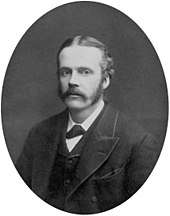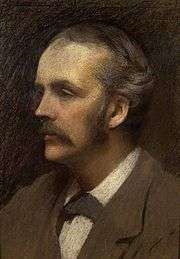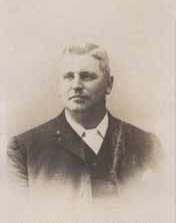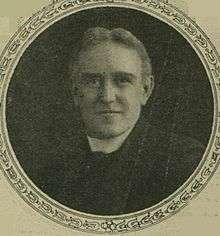Manchester East (UK Parliament constituency)
Manchester East was one of six single-member parliamentary constituencies created in 1885 by the division of the existing three-member Parliamentary Borough of Manchester. It was abolished in 1918.
| Manchester East | |
|---|---|
| Former Borough constituency for the House of Commons | |
| 1885–1918 | |
| Replaced by | Manchester Ardwick and Manchester Clayton |
| Created from | Manchester |
Boundaries
The constituency was created by the Redistribution of Seats Act 1885, and was defined as consisting of the following areas:
- The Parish of Bradford,
- The Parish of Ardwick,
- The Parish of Beswick,
- The part of the Parish of Chorlton-upon-Medlock north of the centres of Cavendish Street, Grosvenor Street, Upper Brook Street, Dover Street, St. Leonards Street, and Cheltenham Street.[1]
The next redistribution took place under the terms of the Representation of the People Act 1918. The Manchester East seat was divided between the two new constituencies of Manchester Ardwick and Manchester Clayton.[2]
Members of Parliament
| Election | Member [3] | Party | |
|---|---|---|---|
| 1885 | Arthur Balfour | Conservative | |
| 1906 | Thomas Horridge | Liberal | |
| Jan. 1910 | John Edward Sutton | Labour | |
| 1918 | constituency abolished | ||
Election results 1885-1918
Elections in the 1880s
.jpg)
| Party | Candidate | Votes | % | ± | |
|---|---|---|---|---|---|
| Conservative | Arthur Balfour | 4,536 | 55.0 | N/A | |
| Liberal | Alfred Hopkinson | 3,712 | 45.0 | N/A | |
| Majority | 824 | 10.0 | N/A | ||
| Turnout | 8,248 | 84.3 | N/A | ||
| Registered electors | 9,779 | ||||
| Conservative win (new seat) | |||||

| Party | Candidate | Votes | % | ± | |
|---|---|---|---|---|---|
| Conservative | Arthur Balfour | 4,160 | 54.2 | -0.8 | |
| Liberal | John Hattersley Crosfield | 3,516 | 45.8 | +0.8 | |
| Majority | 644 | 8.4 | -1.6 | ||
| Turnout | 7,676 | 78.5 | −5.8 | ||
| Registered electors | 9,779 | ||||
| Conservative hold | Swing | -0.8 | |||
Balfour was appointed Secretary of State for Scotland, requiring a by-election.
| Party | Candidate | Votes | % | ± | |
|---|---|---|---|---|---|
| Conservative | Arthur Balfour | Unopposed | |||
| Conservative hold | |||||
Elections in the 1890s

| Party | Candidate | Votes | % | ± | |
|---|---|---|---|---|---|
| Conservative | Arthur Balfour | 5,147 | 52.0 | −2.2 | |
| Liberal | Joseph Edwin Crawford Munro | 4,749 | 48.0 | +2.2 | |
| Majority | 398 | 4.0 | −4.4 | ||
| Turnout | 9,896 | 86.7 | +8.2 | ||
| Registered electors | 11,418 | ||||
| Conservative hold | Swing | −2.2 | |||
Balfour was appointed First Lord of the Treasury, requiring a by-election.
| Party | Candidate | Votes | % | ± | |
|---|---|---|---|---|---|
| Conservative | Arthur Balfour | Unopposed | |||
| Conservative hold | |||||
| Party | Candidate | Votes | % | ± | |
|---|---|---|---|---|---|
| Conservative | Arthur Balfour | 5,386 | 53.9 | +1.9 | |
| Liberal | Joseph Edwin Crawford Munro | 4,610 | 46.1 | −1.9 | |
| Majority | 776 | 7.8 | +3.8 | ||
| Turnout | 9,996 | 83.4 | −3.3 | ||
| Registered electors | 11,991 | ||||
| Conservative hold | Swing | +1.9 | |||
Elections in the 1900s

| Party | Candidate | Votes | % | ± | |
|---|---|---|---|---|---|
| Conservative | Arthur Balfour | 5,803 | 63.4 | +9.5 | |
| Liberal | Alfred Scott | 3,350 | 36.6 | −9.5 | |
| Majority | 2,453 | 26.8 | +19.0 | ||
| Turnout | 9,153 | 71.9 | −11.5 | ||
| Registered electors | 12,727 | ||||
| Conservative hold | Swing | +9.5 | |||

| Party | Candidate | Votes | % | ± | |
|---|---|---|---|---|---|
| Liberal | Thomas Horridge | 6,403 | 59.1 | +22.5 | |
| Conservative | Arthur Balfour | 4,423 | 40.9 | −22.5 | |
| Majority | 1,980 | 18.2 | N/A | ||
| Turnout | 10,826 | 85.1 | +13.2 | ||
| Registered electors | 12,724 | ||||
| Liberal gain from Conservative | Swing | +22.5 | |||
Notable result as Arthur Balfour had led the Conservative Party into the 1906 general election as leader. He therefore became the first leader of the opposition to lose his seat.
Elections in the 1910s
| Party | Candidate | Votes | % | ± | |
|---|---|---|---|---|---|
| Labour | John Sutton | 6,110 | 54.5 | n/a | |
| Conservative | Edward Elvy Robb | 5,091 | 45.5 | ||
| Majority | 1,019 | 9.0 | |||
| Turnout | 88.6 | +3.5 | |||
| Labour gain from Liberal | Swing | ||||
| Party | Candidate | Votes | % | ± | |
|---|---|---|---|---|---|
| Labour | John Sutton | 5,524 | 54.3 | -0.2 | |
| Conservative | Richard Gregory Proby | 4,653 | 45.7 | +0.2 | |
| Majority | 871 | 8.6 | -0.4 | ||
| Turnout | 80.5 | ||||
| Labour hold | Swing | -0.2 | |||
General Election 1914/15:
Another General Election was required to take place before the end of 1915. The political parties had been making preparations for an election to take place and by July 1914, the following candidates had been selected;
- Labour: John Sutton
- Unionist: Gerald Hurst
References
- Sixth Schedule. Divisions Of Boroughs: Number, Names, Contents, And Boundaries Of Divisions, Redistribution of Seats Act 1885 (C.23)
- F A Youngs Jr., Guide to the Local Administrative Units of England, Vol. II: Northern England, London, 1991
- Leigh Rayment's Historical List of MPs – Constituencies beginning with "M" (part 1)
- British Parliamentary Election Results 1885-1918, FWS Craig
- The Liberal Year Book, 1907
- Debrett's House of Commons & Judicial Bench, 1886
- Debrett's House of Commons & Judicial Bench, 1901
- Debrett's House of Commons & Judicial Bench, 1916
Sources
Election Results:
- https://web.archive.org/web/20060520143104/http://www.manchester.gov.uk/elections/archive/gen1900.htm
- https://web.archive.org/web/20060520143047/http://www.manchester.gov.uk/elections/archive/gen1945.htm
Horridge:
- List of Privy Counsellors (1936–1952)
- http://politics.guardian.co.uk/electionspast/story/0,15867,1450577,00.html
- https://web.archive.org/web/20060211081205/http://www.aoqc42.dsl.pipex.com/majauto/autogra01.shtml
Sutton:
| Parliament of the United Kingdom | ||
|---|---|---|
| Vacant since 1894 Title last held by Midlothian |
Constituency represented by the Prime Minister 1902–1905 |
Succeeded by Stirling Burghs |